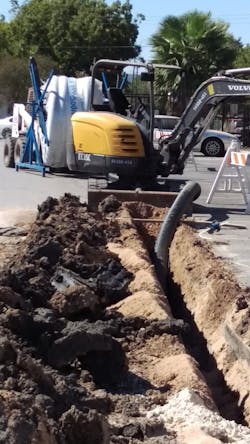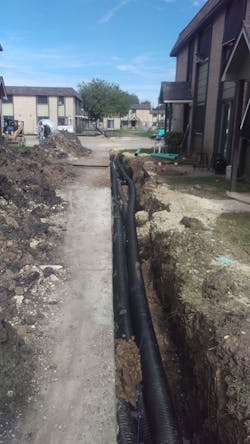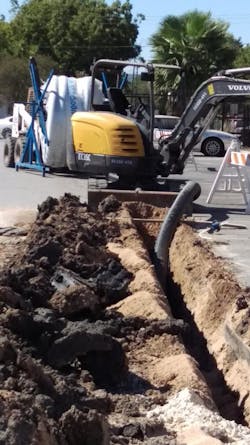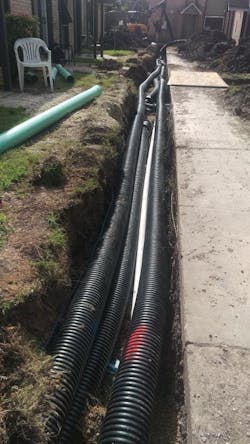Uponor, Contractor Collaborate to Replace Apartment Plumbing System
The Fairway Apartments were in bad shape. The 45-year-old, 172-unit government-subsidized complex was experiencing chronic plumbing issues, including leaks, pressure drops and insulation problems.
According to David Weir, director of sales — National Accounts for Uponor North America, “It was constant, it was ongoing. So the building owners had a full-time guy on the development who was doing patchwork repair… My understanding was that this was a daily thing.”
A big part of the problem? Theft. Anything with scrap value — from copper piping to full-size water heaters — was being stolen in the night.
When the building owners finally decided to bite the bullet and replace the entire plumbing system, they faced three major challenges. First, how to do the changeover without disrupting the lives of the tenants? Many of the people living at the Fairway Apartments were living in subsidized housing because they were elderly or infirm. They couldn’t easily be moved, and they couldn’t be without water in Austin, Texas, in the middle of summer.
Second, how to keep costs under control? And third, how to keep the new piping from being stolen out from under them?
The owners turned to Bill Fowler, president of HHCC, a local Austin general contracting and plumbing firm. The company has been in business since 1989 when it was just Fowler working out of a truck. Today the company does a wide variety of general- and sub-contracting work and has won numerous awards for design/build and historic restoration
HHCC had used PEX piping in a number of applications over the years. In keeping up on the latest developments in plastic piping Fowler had heard about the benefits of Uponor’s pre-insulated, flexible piping system, Ecoflex.
Ecoflex uses a layered, closed-cell, polyethylene-foam insulation and HDPE corrugated outer jacket to provide a long-term retrofit solution. But it was the product’s flexibility that really sold Fowler as a solution to his problems.
“This project was one of the most challenging and difficult underground jobs we have ever done,” Fowler said. “There were so many water, sewer and hydronic pipes and high-voltage electric, telephone and cable TV lines buried, forcing us to hydro-excavate most areas… Ecoflex allowed our installation crew to weave over, under, around and through this maze of difficult utilities.”
HHCC turned to Uponor’s Design Services Department to develop the most efficient plan for the installation. “When we were designing it, we worked by zone,” David Weir said. “We were able to cut the pipes to length and ship them in coils put to length like a jigsaw puzzle. So it was, ‘zone six, length four, units one through eight.’… [HHCC] was able to just uncoil it, connect it to his setup and dig his trench.”
Which proved to be a lucky thing. The three months of the initial phase of the installation saw an unprecedented amount of rain in the Austin area. With the ground saturated, piping had to be put in immediately after a trench was excavated, and then quickly backfilled before the trench could collapse.
Because the pipes were cut to length before installation, possible leak points were eliminated while reducing labor costs. The Ecoflex product is also available in extremely long lengths — up to 600 ft. — for the same reason.
“The long rolls eliminated the need for additional joints that go along with a conventional piping job,” Fowler said, “providing a smaller installation crew and better flow qualities.”
Support staff from Uponor were with the project every step of the way. “[They] visited the site and showed us best installation practices,” Fowler said, “and their engineering staff was readily available to answer questions and provide flow calculations for our mechanical engineer when he needed help.”
HHCC simultaneously replaced the hot, cold and potable water service to the complex. The system moved 413 GPM of hot and cold running water through approximately 5,740 ft. of Ecoflex, 3,390 ft. of which was twin — nearly two miles of piping. Hydronic end suction pumps manufactured by Grundfos/Paco kept all the water moving.
To manage the changeover, HHCC made its final connections in blocks. After all the testing and backfill, they would leave the stub for the final connection exposed. “Then, on a particular day,” Weir said, “they would commission that unit. They wouldn’t shut the unit down for more than two or three hours.”
Fowler has been so happy with the performance of the Ecoflex product that he’s altered his business model, taking on more plumbing retrofit jobs, charging the same amount, but finishing them in less time and with far fewer hassles.
“The insulation, the flexibility, the large-diameter expansion fittings and the long lengths… all contribute to make this the most viable product of it’s kind on the market today,” Fowler said.
As an added bonus, no one is going to try and dig it up to re-sell it. “Ecoflex isn’t cheap,” Weir said, “but it has no scrap value to it.”
Photos courtesy Uponor.



